Most RVs have two different types of electrical systems: 12 volt and 120 volt. The
previous page
discussed the 12v system supplied
by the battery(s) contained in your rig. 120v are supplied by
so-called "land line" or "shore" hookups, the type you find at any full service campground. The
term shore power comes from the boating world, where boaters tie up to a dock or pier and plug into
hookup boxes. Interestingly, the plugs and receptacles used for boats are pretty much the same as we RV-ers use.
These discussions first cover the various components comprising your 120v RV electrical systems. Then we go into
various maintenance routines to keep your rig's electrical system humming. Finally, we provide some
suggestions regarding what to do when inevitable electrical problems crop up.
You will see references to the terms "male" and "female"
when referring to the ends of electrical cords, adapters, plugs and receptacles. A 120v receptacle (aka socket) is
always female, meaning that it has holes in it much like the 120v outlets in your home. Female receptacles represent
the "business end" of an electrical connection. They're are designed to prevent shock by touching them,
serving as protection from kids, drunks and idiots. Imagine what would happen if
the reverse were true, if live receptacles had pins sticking outward rather than inward!
Male plugs, on the other hand, do have pins sticking outward but they do not have current running through them
until they are inserted into a compatible female socket that does,
and by then the pins are "covered" so you can't touch them.
So, current flows when a male plug is inserted into a female socket.
The concept of inserting male connectors into female sockets can be extended indefinitely by using extension cords
or connectors, although it's not a good idea in practice due to the increase in wire resistance (and danger of
fire) with each extension added.
To help you follow along, here is a diagram of the electrical system in our particular fifth-wheel.
Your's may be different, so I encourage you to look for appropriate
diagrams on the 'net. Click on the diagram to enlarge it, or
click here to see it in a separate window.
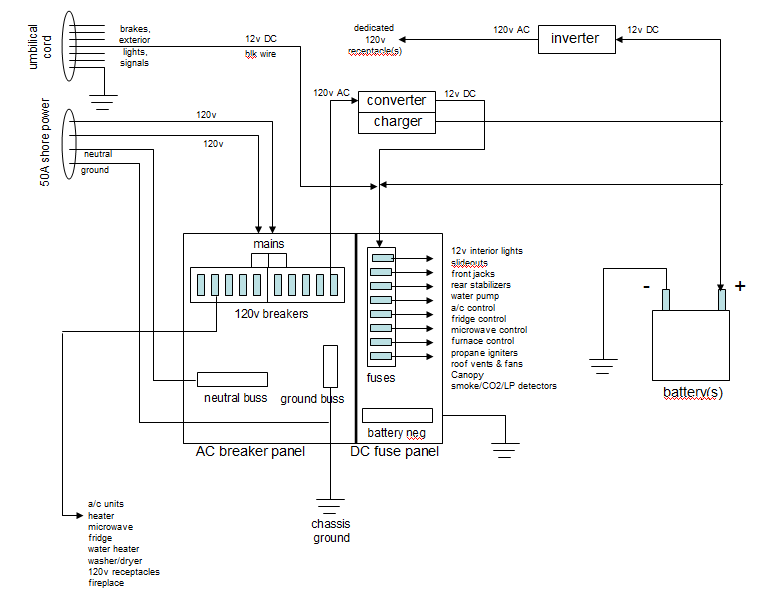
|
|
[click to enlarge]
|
If you're into gore, here's a much more sophisticated
example diagram of a motorhome with a generator, converter, inverter,
multiple batteries and solar panels.
Wire gauges
If you plan to do any wiring in your rig, it is vital that you understand the importance of
wire sizes, referred to as
wire "gauges". Any wire has a property called "resistance", which simply means that any wire has a tendency to
resist current flow. As electrons pass through a wire it heats up. For a given current, the smaller the wire's diameter the more heat it will give off. Consider the old
style incandescent light bulb. The filament inside is a very thin wire which gives off light as current runs through
it. It also gives off heat, as anyone knows who has tried to grab an old-fashion 100 watt bulb after it's been on for awhile.
The problem is that as a wire gets hotter and hotter it can become damaged, or worse, actually burst into flame.
As you might imagine
this wouldn't be good for your rig! This is why choosing the proper wire gauge for your application is important.
Safe wire sizes are a factor of the length of the wire as well as the amount of current that will be flowing through it.
Always look up recommended wire gauges before you install any equipment in your rig.
Again, the internet is your friend.
Here is a chart from
Solaris Technology Industry, Inc of
wire gauges needed for different current levels (in amps). Unless you're an electrician, the only two columns you
would be interested in are the ones for wire gauge and amps. Click on the diagram below to view a readable version.
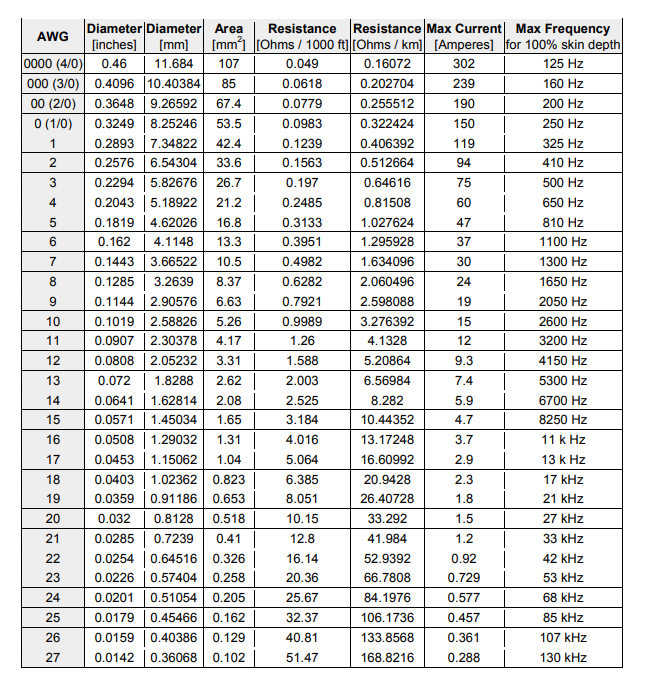
|
|
[click to enlarge]
|
| ☞ | |
Contrary to intuition, wire gauge numbers get smaller the thicker the wire; that is,
increasing gauge numbers denote decreasing wire diameters. So "gauge" is essentially an inverse measure of a wire's
cross-section. Curiously, the original meaning of
gauge referred to the number of times a wire had to be drawn through the forming apparatus to achieve the
desired thickness. 30 gauge wire had to make more passes through the drawing dies than an 8 gauge wire.
|
The cross-sectional area of each gauge is an important factor for determining its safe current-carrying capacity
(its "ampacity"). That's why having the proper gauge wire is critical for any wiring project.
The American Wire Gauge (AWG) tables above are for a single, solid, round conductor.
The AWG of a stranded wire is determined by the
cross-sectional area of an equivalent solid conductor. Because there are small gaps between the strands,
a stranded wire will always have a slightly larger overall diameter than a solid wire with the same gauge.
You will see the term "heavy gauge" wire. Again, contrary to
intuition, the heavier the gauge, the lower the gauge number. Hence, an 8-gauge wire is "heavier" than a 10-gauge wire.
The term "heaviness" refers to the amount of current it can conduct without overheating. But note that heavy gauge
wires are heavier in the physical sense also.
| |

|
The table above applies to both AC and DC currents.
Most of the gauges you would be working with run from #7 thru #21. You can always use a thicker wire
(lower gauge nr) than shown as long as the wire fits into its connection. Keep the following rule in mind:
the higher the amperage flowing through the wire, or the longer the wire, the thicker the wire needs to be.
Be aware that braided wires can carry more amperage than solid wires.
Standard jumper cables usually have a 6-gauge rating.
There is actually another wire gauge standard, the Society of Automotive Engineering (SAE).
See here for comparisons
between that and the AWG standard. When you purchase wire you should know the difference between the two.
If you want to determine any of the wire gauges in your rig, here is a wire gauge
measurement tool available at Amazon. One good thing about it is that you don't have to disconnect a wire
from a circuit to use it. And it's cheap. But in order to get an accurate gauge measurement with any tool, it's best to
strip off insulation and measure the bare wire, but make sure you turn off the current first!
120 volt systems
-- distribution system == breaker panel
First off, let's clear up some confusion. You will see discussions of things like house current where some folks
talk about 120 volts and others talk about 110 volts. So what's the difference? The answer is, none. They are
different terms for the same concept and can be used almost interchangeably. Power generated by the power company
starts out as 120 volts (the "nominal" voltage), but line drops such as transmission losses often reduce
the voltage to somewhere
around 110 volts by the time it gets through your electric meter, into
your circuit breaker panel and then down the line to your appliances.
As a result, you can expect voltages to vary somewhere between 120v and 110v. Most all home
and business appliances are engineered to operate in the range between the two.
Ok. Now we can comfortably discuss 120v and know that we're actually talking about both 120 and 110 volts.
Regarding your rig, you will encounter campground electric hookups that provide current with amperages
of 15A, 20A, 30A or 50A. Each of these has its own ramifications.
The following items all require 120v service in order to operate correctly:
- Air conditioner(s)
- Water heater [except propane]
- Furnace [except propane]
- Refrigerator [except propane]
- Microwave
- Central vacuum
- Converter
- Electric outlets, including GFI
The following table shows rule-of-thumb minimum wire sizes for various current draws. This
table was not taken from an official source but rather shows general guidelines for 120v
hookups. Increase wire sizes by one for runs greater than 100 feet.
| ☞ | |
Wire gauge numbers increase as the diameter of the wire decreases.
|
| Length | 15A | 20A | 30A | 50A | 100A |
| 25 feet | #14 | #12 | #10 | #8 | #6 |
| 50 feet | #12 | #10 | #8 | #6 | #4 |
| 100 feet | #10 | #8 | #6 | #4 | #2 |
Remember that these are only guidelines. Do some research if you think you have
unusual circumstances. Also bear in mind that wire size increases may be called for
in unusual circumstances such as bundled or coated wires than cannot expend heat well.
120v distribution panel (aka circuit breaker panel)
All of your 120v appliances go through a panel that contains
a bank of 120v circuit breakers and a bank of 12v fuses. Mine is located under one of the stairs.
Circuit breakers have different
amperage ratings depending on what they are servicing; for example, 20A for A/C,
and 15A for most other things. 12v fuses likewise have different amperage ratings, like 20A for
slideouts and 15A for lights.
See here for a complete discussion of your
rig's 12v system.
Here is
a diagram of the panel on our fifth-wheel. Your's is likely to be similar.
I always carry spare fuses with me when we travel, a couple extras for each of the different
amp ratings. But it's probably not worth taking spare circuit breakers as they rarely break.
15/20 amp service
This is commonly referred to as ordianry house current.
Unless your rig is specifically designed to do so, DO NOT expect everything
to work normally when connected to 15/20A service. You
definitely will not be able to run two a/c units at the same time.
In fact, you might not be able to run one if other things are in use at the same time.
Consider one or more house fans as an alternative. Microwave ovens, toasters and
hair dryers are known power hogs and can easily throw a main breaker if used all at the same time.
That said, you may have to hook up to 15/20 amp service from time to time. The classic example
is dry camping - your generator may not be able to output more than 15/20A. Experienced dry campers
develop a routine of frugality and tend to limit themselves to 12v lighting, and using power-hungry
appliances sparingly and one at a time. Another reason for using 15/20A is if you park at a friend's
house and hook up to their house current.
Here are a couple caveats. You will likely need to get an
adapter to plug your 30/50A power cord into a 15A/20A hookup.
Some smaller rigs will have built-in 120v plugs, but most larger rigs will not. When you buy an
adapter be sure that one end fits into your rig's 30A or 50A socket and the other end has a male connector
for a standard (eg, house type)
3-prong 120v line. The other caveat is to use as short an extension cord as you can get away with; longer
lines can lead to overheating problems. If your extension cord gets too hot to hold, it's trying to
tell you something!
30 amp service
|
The 30 amp hookup boxes that you'll find at RV parks have 3-slot female receptacles which 4-prong male
plugs fit into. Note in the picture at right that the center hose does not represent a connection; it's
just a hole.
See here and
here
for good discussions of 30 amp RV wiring. For the geeks among you, RV 30A plugs are defined by
ANSI standard TT-30P (the plug) and
TT-30R (the receptacle). For the less geekish among us, the plug is simply known as RV30.
More geek: 30A @ 120V = 3600 watts [amps * volts = watts].
|
|

|
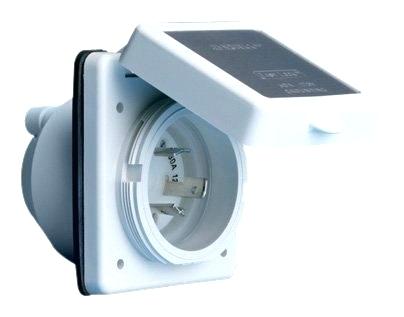
| |
[click to enlarge]
|
| |
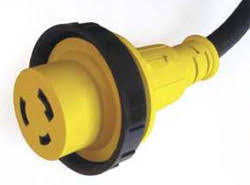
| |
[click to enlarge]
|
|
If you look closely at the above photos you will see that one of the pins is curved. This serves two
purposes. First, it ensures that you won't try to use the wrong type of plug. Second, it helps secure
the plug in the receptacle.
A 30A RV plug looks similar to the 240v plug you see for household dryers or water heaters,
but they ARE NOT interchangable - don't even think about trying it! For one thing, 240v house plugs
are wired with two hot lines; RV30 plugs are 120v with only one hot wire - the other two are
for neutral and ground. See the links above for more detailed info.
The following pic from
NoShockZone.org
shows the differences.
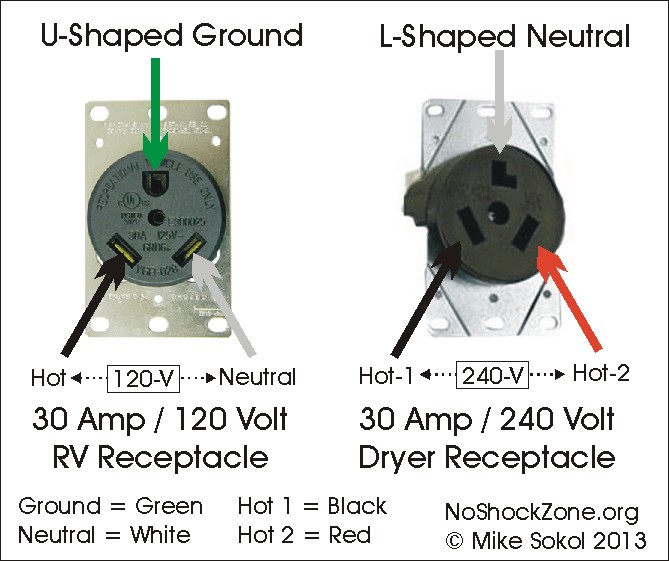
|
|
[click to enlarge]
|
If you need to buy a replacement plug, go to an RV dealer, Home Depot, Lowes, Camping World
or an electrical supply house. Make sure you get the RV30 connector and not the 240v clothes dryer type.
And DO NOT try to make your own or use something else.
The cables used to connect between your rig and the hookup box have to be rated for such use.
Don't try to get by with regular 30A extension cords. Your best bet is to get one from an RV
dealer, although it may be a bit more expensive. 30A power cords should be at least 10 gauge or lower.
Finally, although I don't encourage it, you can connect a 30A RV into a 50A campground box.
This may sound dangerous but it's probably ok since the appliances in your rig likely won't draw more than 30A anyway.
Just because the hookup box is able to provide up to 50A of current, that would only be the case
if your rig could somehow draw more than 30 amps at once. For example, rigs designed for 30A normally do not have
more than a single A/C.
Also, bear in mind that your circuit breakers in your rig would likely throw if they detect more than 30A
flowing through them. And also consider your 30A power cord. It cannot handle 50A without causing severe overheating
and this could cause cable damage or, worse, a fire. Be sure to plug your 30A-50A
adapter directly into the hookup box, not the rig itself.
This immediately converts the current to 30A before it can cause bad things to happen to your power cord.

|
|
[click to enlarge]
|
50 amp service
Most larger rigs use 50A service.
|
You will notice differences between 30A and 50A sockets, plugs and cables. First, 30A sockets and plugs
have three pins; 50A ones have four. Second, 50A cables use fatter (8 gauge)
internal wiring rather than 12 gauge, so the cables are thicker and quite heavier.
The wiring for the two types is also different. 30A cords are wired with 120v on one pin, and neutral and
ground on the other two. 50A cords are wired with 120v on two of the pins, and neutral and ground on the
remaining two pins.
| |

|
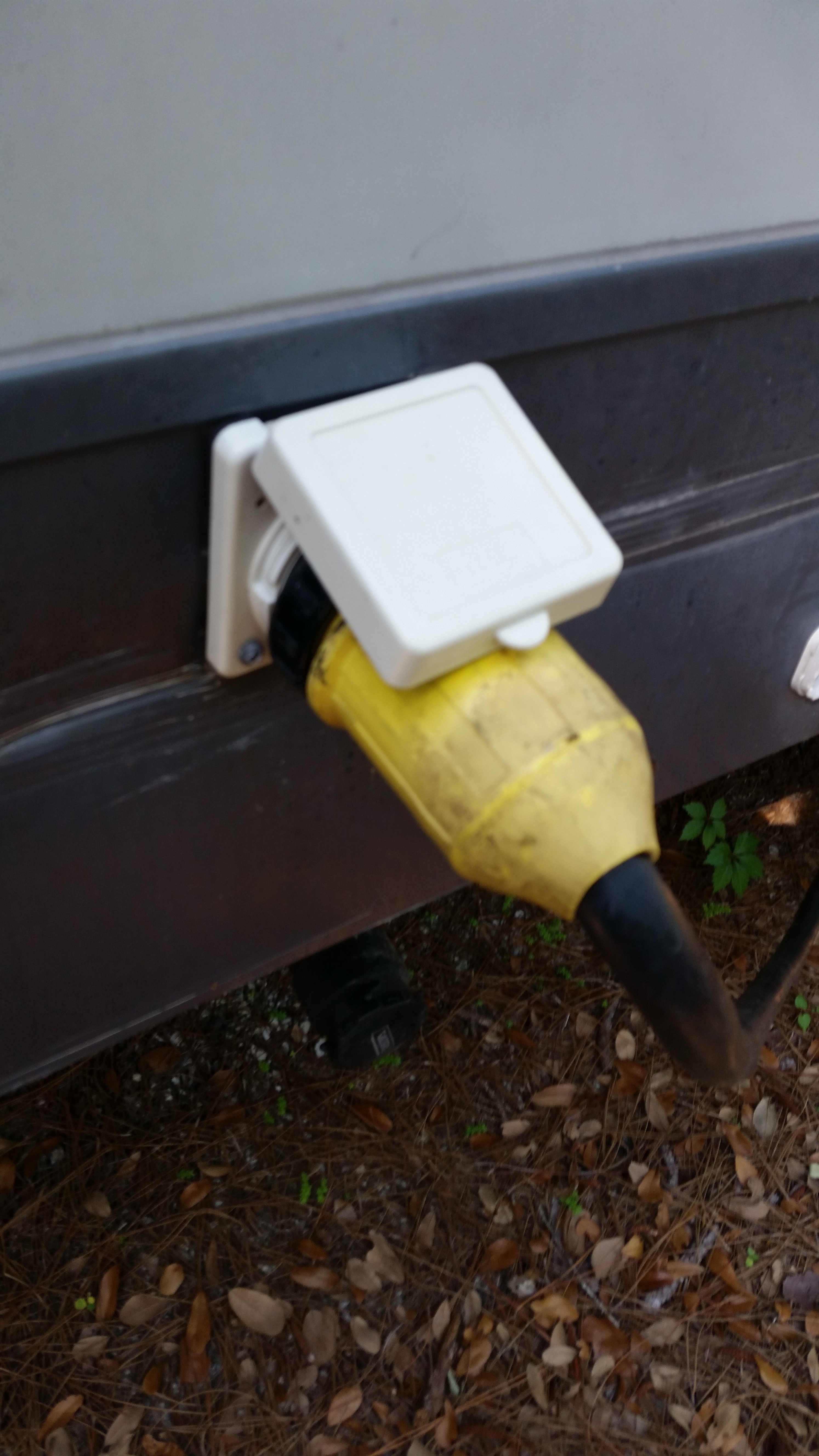
|
|
[click to enlarge]
|
I think most RVers have no idea that their 50A hookup cord actually provides 240v to their rig's breaker box. There
are, in fact, two 120v circuit breakers at the panel, one for each leg of the 240v. The 240v is thus split by the
breaker box into two legs, each serving different 120v lines. If you were ever wondering, this is why a
rig with two A/C units have their breakers on separate mains of the breaker box.
If you've ever wondered how the 4 pins on your rig's hookup side male receptacle are wired, you might
find the following diagram
useful. Note that the ground (green) pin has a little hook on it. This guarantees that you won't
plug your cord in wrong and cause big problems.
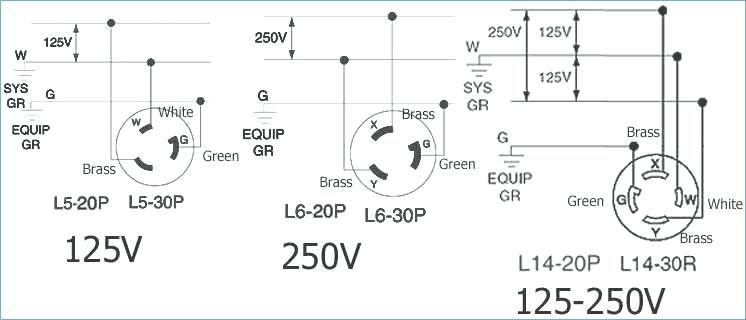
|
|
[click to enlarge]
|
-- 50A * 2?
-- dielectric grease on the connector when you plug in
-- had to replace - got at dealer - can be found at Home Depot, Lowes, Camping World, elec supply houses
Adapters
If you plan to stay at a lot of RV campgrounds, be prepared to occasionally
get a site where the electric hookup service
doesn't match up to the amperage your rig expects. This can often be the case if you don't have the luxury
of making reservations beforehand, of if you camp at places like state parks.
And often even if you do make reservations you may elect to take a site with incompatible service because of
other considerations, like trees or water.
For example, we have a 50A fifth-wheel,
and many times we've stayed in sites where the only service was 30A.
This isn't a particular problem in itself since we've learned to adapt by running
only one A/C, and to be careful how many appliances we run at once.
"Turn off the A/C, I'm going to use the microwave."
"Don't use the microwave, I'm going to blow my hair." These are some of the routines we get into when hooking
up to 30A service.
In Canada, 30A service seems to be the norm. I think less than 20% of the sites we stayed at in the
Canadian Maritimes had 50A hookups.
The answer to amperage mismatches are power cord adapters.
Adapters allow you to plug your power cord into a hookup box with a different amperage, and hence a different
socket type. If your rig normally operates on 50A and your campground site hookup box only provides
30A then you'll need a 30-50 amp adapter.
If your rig only uses 30A but the hookup box serves 50A then you'll need a 50-30 amp adapter.
If you're parked next to an outlet that only provides 15A or 20A (for example, at a friend's house)
and your rig uses either 30A or 50A then you'll need yet a different type of adapter.
Many RV-ers initially find adapter lingo a bit confusing. Which amperage goes on which end? Where does the male
plug go? The female receptacle? Which end of the power cord do I put the adapter on. What size wire does an
adapter need? I had the same questions at first, but take heart. After reading this section you should understand
everything you need to know about adapters.
Unfortunately, the world in general, and the advertisers on Amazon in particular, don't seem to adhere to any
standard terminology. For example, both of these are advertised on Amazon as 30-50 adapters.
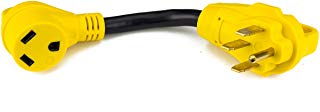
| |
[click to enlarge]
|
| |

| |
[click to enlarge]
|
|
|
So we can all get on the same page, let's adopt the terminology for adapters as being 'H-to-R',
where the 'H' indicates the amperage supplied by a hookup box (or generator)
and the 'R' indicates the amperage supplied at the other end of the adapter. For instance,
in order to hook up a 30A rig to a 50A box you will need a 50-to-30 amp adapter
with a 50A male plug on one end and a 30A female receptacle on the other. Now you can plug the male end
of the adapter into the hookup box, and the male end of your 30A power cord into the female end of the adapter.
Some adapters like the ones show above are called "dog bones" because of their appearance.
Others may be a longer integrated combination of adapter and power cord.
The following diagram shows all combinations of adapters you are likely to use.
| |

|
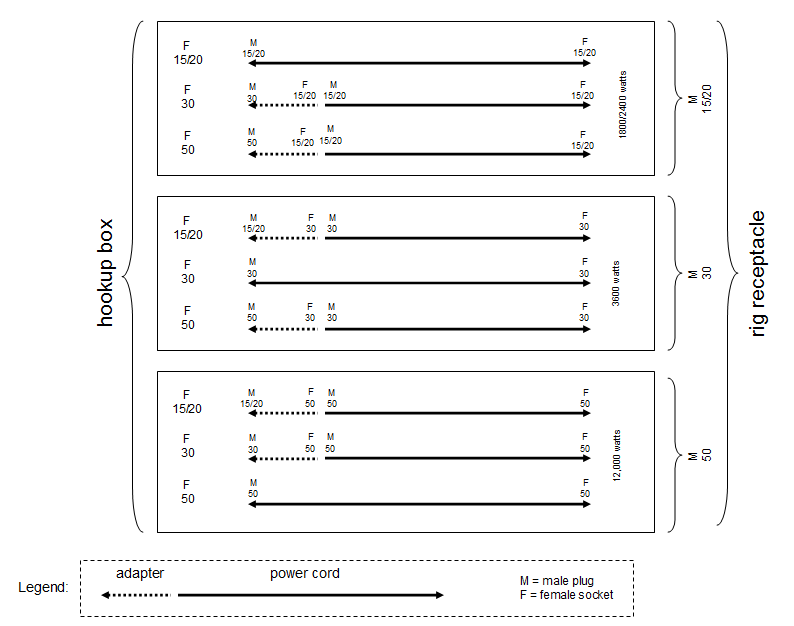
|
|
[click to enlarge]
|
There are two constants seen in the above diagram. First, every adapter has a male end that plugs into the hookup box,
and a female end that your power cord plugs into. Second, for power cords and their adapters, male plugs always
orient toward the hookup box while female receptacles always face toward the rig.
Note that 30-50 adapters, with male plug on the 30A end and female socket on the 50A end, look like 50-to-30
amp adapters but have 50A male plugs and 30A receptacles.
| ☞ | |
If you hook up a 30A rig to a 50A box, it is very important that
you place your 50-to-30 amp
adapter right at the box itself. This will ensure that you don't have 50A power flowing through
your 30A cord, possibly overheating it and causing big problems.
|
| ☞ | |
If you use an adapter, surge protector or any other extension on your power line,
be sure to place them so that the female sockets are laying toward the ground.
This prevents rain water from accumulating in the connection. This has in fact
happpened to me, resulting in a shorted and burned out surge protector. If you
cannot face the female connector downward then wrap with some black electrical
tape, or at the very least cover it with something that won't blow away.
|
-- 50A on 30A adapter not protected by internal breaker
12v-to-120v inverter
While most rigs come with converters most do not have inverters, except for possibly the most expensive.
Being unfamiliar with them, questions often asked go something like "What is it? Do I need one? Are there different
types?"
An inverter is a very handy thing to have if you do dry camping. It's purpose is to convert
12v battery voltage into a weak form of 120v current. Basically, it allows you to briefly run 120v
appliances such as TVs, microwaves, hair driers and so on. But don't count on being able to run
power hungry devices like your a/c or fridge for long.
- What is it?
- Do i need one?
- How do I hook it up?
-- ways to wire inverter [http://www.doityourselfrv.com/rv-inverter-install-diy/]
-- different types
-- inverter normally does not come with rig
-- inverter/converter/charger - dont recommend it - tech too new, wait for price to come down, work out the kinks
eschew new Windows versions
-- inverter => emergency use? not good for boondocking - for "pullover" [have generator, but cant run or dont want to]
-- extn cord w/inverter?
-- dedicated inverter receptacle (120v)?
-- should inverter always be connected to battery
Also note that the current produced by a cheap inverter is low, maybe 75 watts. However, if you want
to spend a lot of money on an inverter you can generate up to 75,000 watts but that's probably a little
ridiculous for the average RVer. More typical units would be a 600 watt unit for around $400, or a 3000 watt
unit for around $800. As you can see, inverters are probably luxuries for casual boon dockers. A more
reasonable solution might be a gas and/or propane powered generator. A 3500 watt, 30A gas generator can be
had for around $350.
| ☞ | |
Never try to connect your inverter directly into the AC breaker panel in your rig!. For one thing it just won't supply
enough power to drive all the things fed by that panel. For another, there is too much danger the inverter will
still be connected when you return to shore power and the extra amperage could fry the inverter's electronics.
You can connect the inverter indirectly to the AC panel via what is called a transfer switch (see below).
A better alternative is to wire the inverter up to one or more dedicated outlets in your rig, and mark
them accordingly. An extension cord or two might also be handy.
|
| ☞ | |
Do not, repeat, do not have the inverter's 120v output connected directly or indirectly to either shore or generator
power.
|
| ☞ | |
Also never have your inverter and converter on at the same time. Otherwise you will have a closed loop system
where the inverter is drawing current from the battery, while at the same time the converter is trying to charge it.
|

Inverters typically run from about 75 watts output up to around 5000 watts or more. The lower rated ones are generally
used for utility applications and can be plugged into a vehicle's cigarette lighter. Higher rated ones will
need to be hard-wired to the house battery, as close to the battery as possible. I recommend you use
the lowest gauge wire that will fit your inverter's output terminals.
Here are several ways you can wire up your inverter. You can use standard 14 gauge wire for the 120v outputs.
- Use a transfer switch to connect the inverter to the 120 v AC panel. The switch will automatically switch between
shore (or generator) power and the inverter. Internal circuitry will choose shore power if it is available; if not,
then the inverter will be used.

- Install one or more dedicated AC outlets in the rig. Run normal household Romex wire between the 120v AC outlet(s)
and the inverter. Be sure to mark the dedicated outlets so they won't be used when you're not on the inverter.
- A neat solution that I've seen elsewhere is to install a 15/20A, 30A or 50A female receptacle on the exterior
of your rig. This will be a duplicate of the one you use for shore power. Wire the new receptacle to the output
of your inverter. You can then move your power cord plug between the inverter-connected receptacle and the
normal shore power one. The beauty of this solution is that it allows you to use your normal receptacles in the
rig without having to deal with dedicated receptacles. Make sure your inverter has enough power to do this, though.
How much power should you look for when deciding to get an inverter? Here's a cheapo calculation that should serve.
Multiply
the highest breaker amperage by 120 to get the minimum wattage you need. For example, if your highest breaker draws
30A for the air conditioner, you will need as a minimum 120 x 30 = 3600 watts. But notice you might not be able to
run many other things while the A/C is on, and you certainly can't run two A/C units. The moral is that if you have
a big rig with lots of appliances, get an inverter with the most wattage output as you can afford. Also make sure
that it's a
pure sine wave inverter.
Since inverters (like converters) have inherent inefficiencies, they will drain the battery much sooner than you
would like. Due to heat loss this will happen even if you do not have any 120v appliances plugged in.
120v maintenance and repair
There won't normally be much for you to do in the way of maintaining your electrical system,
other than periodically checking battery fluids and connections. But
what do you do when something does go awry?
The most dreaded electrical system problem is when power just completely goes out,
especially at night. What you
look for depends on whether it is the 100v or the 12v that fails.
Here are some typical causes of partial or complete power failures,
listed in order of likely causes.
- Switch on hookup box not switched to "on"
- Thrown circuit breakers, either in your rig or at the campground's power source
- Thrown GFI receptacle
- Bad hookup box receptacle
- Bad rig receptacle
- Power surges (see below)
- Inadequate wire size
- Loose connections, perhaps due to vibrations
- A short in the line
- Burned-out parts such as receptacles or circuit breakers
- Bad wiring, maybe by an unwitting electrician who thought your 30A receptacle
should be wired like a house close dryer outlet
- others
|
If you don't have a voltage detector, get one. It's hard to trace down electrical failures without one.
I prefer the kind that looks like a fat ball point pen,
and either lights up or beeps (or both) when voltage is detected. They work by detecting the flux generated by
alternating current; therefore, you only need to place them next to an electric line to see if current
is flowing. The type shown at the right can detect voltages from 12v up to 1000v. They can generally be had for
around $20 US.
|

|
Let's start out with tracking down 120v outages. The likely starting point would be the hookup box outside.
Check to make sure that the cord is securely plugged into the box. I once spent an embarrassing hour or so localizing
a power failure only to discover that the plug had come loose from the box because I had earlier pulled the trailer
up a couple feet. Also check to see if there is a switch on the box that turns electricity on and off. I have
overlooked this often enough that it is now one of the first things I check. If you're sure you have power at the box (by testing it with your handy-dandy voltage detector), make sure
the line is still securely plugged into the female receptacle on your rig.
The next logical thing to check is to see if the main circuit breaker in your rig has been thrown.
Just to be sure, you
can throw it back and forth and see what happens. Depending on how your breaker box is laid out, you may be
able to test the main with your voltage detector, but maybe not. This would also be a good time to check all
the other breakers in the box to see if any have been flipped. It is also possible albeit unusual to have a
circuit breaker dysfunction.
By the way, although it doesn't happen often it is possible that a campground circuit breaker has been thrown.
This has happened a couple times to me, and I had to go find campground personnel to reset them. This would
most likely be the culprit if your tester shows you have no power at the box. And don't discount the
possibility that the box receptacle itself may be bad. This has also happened to me at least once.
Less frequent causes of problems include plugs going bad on either end of your electric cord.
I have seen a neighbor camper's 30A cord end burnt out, presumably due to overloading. Also,
your rig's male receptacle going bad is not out of the realm of possibility;
this is especially true if you do a lot of wiggling around when connecting up your cord.
-- maintenance - grounding, secure mechanical connections, test with detector, multimeter
So what do you do if all these things are fine and the problem still exists? You've checked everything
from the campground hookup all the way up to your circuit breaker box and everything looks ok. Well, it's probably
time to get a professional. Either take your rig down to a dealer, or try to find out if
there is a mobile RV repair service in the area. I wouldn't recommend hiring a non-RV electrician
because they generally are not experienced in the pecularities of RV wiring. This may be a
last resort, but be prepared for a hefty bill. Oh, don't forget to ask at the campground
office if they know anyone in the area that does RV electric.
-- vibrations
-- insulation
-- short
-- unplugged converter
-- reset GFI
--
Electrical problems
If you are connected to an electrical hookup but are not getting power to the unit,
look for the following: (a) the circuit breaker at the hookup box is not on [usually
in the up position], (b) the plug is pushed in all the way, (c) all adaptors and voltage
protectors are snug, and (d) the other end of the line is snugly pushed into the trailer.
Embarrassing as it is to say, I once had a plug come out of the hookup box when I pulled
the trailer up a few feet to better line up with the sewer connection. I did all kind
of electrical troubleshooting before I finally decided to go out and check the plug. Doh!
If your 120 is fine but the 12 v lights are dim, make sure that your converter box is
plugged into a 120 receptacle. I once had the plug fall out due to travelling on a
particularly bumpy stretch of road in Newfoundland. A bad or dead battery can also
cause 12 v problems.
If you are connected to an electrical hookup but are not getting power to the unit, look for the following:
(a) the circuit breaker at the hookup box is not on [usually in the up position], (b) the plug is pushed in
all the way, (c) all adaptors and voltage protectors are snug, and (d) the other end of the line is
snugly pushed into the trailer. Embarrassing as it is to say, I once had a plug come out of the hookup
box when I pulled the trailer up a few feet to better line up with the sewer connection. I did all kind
of electrical troubleshooting before I finally decided to go out and check the plug. Doh!
If your 120 is fine but the 12 v lights are dim, make sure that your converter box is plugged into a 120
receptacle. I once had the plug fall out due to travelling on a particularly bumpy stretch of road in Newfoundland.
A bad or dead battery can also cause 12 v problems.
120v appliance loads
The following table shows average current draw for typical RV appliances.
Your particular devices may draw more or less current than shown in the table.
The chart is meant only for guidelines as to what combination of appliances you can
safely run using your 20A, 30A or 50A service. Notice especially why running two
a/c units on 30A service is a bad idea and is likely to kick one or more of your breakers.
Note that any appliance that draws more than 8 or 9 amps can be thought of as a "power hog"
and should be used with caution when hooked up to a 30A line or less.
| Appliance | *
Current
(in amps) |
Comments |
| Washer dryer - twin - large | 30 | |
| Microwave | 20 | At startup; 15A after startup |
| Air conditioner(avg 14K BTU rooftop) | 15 | Startup draw; 7A after startup |
| Furnace fan, 1/3 hp | 14 | |
| Hair dryer | 13 | Less powerful hair dryers might be better for RV use |
| Water heater - 6 gal | 12 | While in 120v mode; no current draw in gas mode |
| Space heater | 11 | |
| Central vacuum | 11 | |
| Toaster, toaster oven | 10 | |
| Hot plate | 10 | |
| Refrigerator/freezer | 10 | In 120v mode, not gas |
| Electric frying pan | 10 | |
| Waffle iron | 10 | |
| Clothes iron | 10 | |
| Coffee maker | 9 | While making coffee; ? while keeping warm |
| Food processor | 9 | |
| Hair dryer | 8 | |
| Winegard RV-7042 wall-mounted TV/cable switch 12v outlet | 8 | |
| Battery charger | 8 | |
| Electric stove element | 7 | |
| Curling iron | 6 | |
| Converter | 6 | While charging battery(s) |
| Curling iron | 5 | |
| Electric drill | 5 | |
| Coffee pot | 5 | |
| Corn popper | 5 | |
| Food processor | 4 | |
| Digital TV | 3 | |
| Computer | 3 | Desktop; 1A for laptop; 2A for printer |
| 12v lights | ? | |
| Electric broom | 3 | |
| Blender | 3 | |
| Electric blanket | 3 | |
| Satellite dish & receiver | 2 | |
| Small vacuum | 2 | |
| Crock pot | 2 | |
| Hand vacuum | 2 | |
| Electric fan | 2 | |
| Can opener | 2 | |
| Heating pad | 2 | |
| Winegard RV-7042 wall-mounted cable connector | 2 | |
| Mixer | 1 | |
| Radio, stereo, DVD, VCR | 1 | |
| LED mini-lights; eg Christmas | 1 | |
| Electric shaver | 1 | |
Generators
-- our gen is gas/propane
-- dont leave gas in generator for long time, will clog up
-- pushers usually have on-board generator
Surge protector
To protect all the electrical goodies in your rig, you should consider getting a surge
protector. Its function is similar to the ones used in household applications, such as
protecting a computer from voltage or current spikes. But they do look different.
-- picture
Surge protectors connect in-line with your 20A, 30A or 50A power cord, and can sit
anywhere between the hookup box and your rig's male receptacle. For example, one
conceivable situation, working from the rig to the box, might be a 50A power cord,
then a 50A surge protector, and finally a 50A-to-30A adapter which plugs into the campground's
30A hookup box.
My advice is to buy the best surge protector you can afford. In the event of power surges,
no protector or a poor protector can result in severe damage to your rig's electronics, your
a/c units, your fridge or your converter box - or all of the above.
Power surges can arise from a number of situations:
- excessive power increases from the power company
- mis-wired hookup boxes or rig receptacles
- old, worn power hookup box receptacles
- lightning strikes
How can a receptacle get miswired, you ask? ---
-- Electrical Monitoring System
I ran across
this DVD item
while doing some searches on the internet. I haven't purchased it
myself, but if you consider yourself a rank newbie when it comes to RV electrical systems,
it may be worth a try. I make no warrants about its content or usefulness.
Battery maintenance
Elec problems:
fuses & circuit breakers - do you have extras?
converter might have come unplugged, especially on bumpy roads
site elec box - do you have a multimeter?
trailer receptacle for plug
elec line - do you have an extra?
-- my ground pin broke off, but no worries